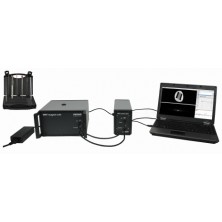Item no.: P5942100
Principle
The fundamental principles concerning the phenomenon of nuclear magnetic resonance (NMR) are demonstrated. Experiments are executed with a MRT training device giving the opportunity to investigate some small probes in the sample chamber. Device control is done with the provided software. Investigations comprise the tuning of the system frequency to the Larmor frequency, the determination of the flip angle of the magnetisation vector, the effects of the substance quantity, the influence of particular magnetic field inhomogeneities, the measurement of a spin echo signal and an averaging procedure to maximise the signal-to-noise ratio. The adjustment of all parameters in these experiments are inevitable to obtain an adequate MR image.
Tasks
- Tuning of the system frequency to the Larmor frequency.
- Setting of the HF (High Frequency) pulse duration to determine the flip angle of the magnetisation vector.
- Effects of the substance quantity on the FID signal (Free Induction Decay) amplitude.
- Minimising magnetic field inhomogeneities via a superimposed magnetic field (shim).
- Retrieving a relaxated FID signal via a spin echo flipping nuclear spins by 180°.
- Improving the signal-to-noise ratio (SNR) of the FID signal.
What you can learn about
- Nuclear spins
- Atomic nuclei with a magnetic moment
- Precession of nuclear spins
- Magnetisation
- Resonance condition, MR frequency
- MR flip angle
- FID signal (Free Induction Decay)
- Spin echo
- Relaxation times (T1: longitudinal magnetisation, T2: transverse magnetisation)
- Signal-to-noise ratio
Software included. Computer not provided.

